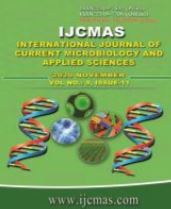


 National Academy of Agricultural Sciences (NAAS)
National Academy of Agricultural Sciences (NAAS)

|
PRINT ISSN : 2319-7692
Online ISSN : 2319-7706 Issues : 12 per year Publisher : Excellent Publishers Email : editorijcmas@gmail.com / submit@ijcmas.com Editor-in-chief: Dr.M.Prakash Index Copernicus ICV 2018: 95.39 NAAS RATING 2020: 5.38 |
Currently agriculture is facing challenges like increase in global population, hunger and extreme poverty due to which rate of agricultural yield increase has declined. The main reason behind declined agricultural yield is abiotic stresses suffered by sessile plants. Salinity and drought are two major abiotic stresses which result in yield losses for example it is estimated that drought and salinity may cause 50% loss in crop production. In the fast moving world, a new technique of nanotechnology is adopted to overcome this problem. Zinc oxide nanoparticles are the particles which have dimension between 0-100nm. Zinc is one of the most important micronutrient used in different physiological processes like hormone biosynthesis, synthesis of chlorophyll and cofactor of enzyme like carbonic anhydrous, superoxide dismutase etc. Zinc oxide nanoparticles on the other hand are are less toxic, comparatively inexpensive and biocompatible nanoparticles as compared to other metal oxide nanoparticles because zinc does not interact with the majority of pharmaceutically active molecules. ZnO has been “generally recognized as safe (GRAS)” material by the Food and Drug Administration and is utilized as a food additive. Zinc oxide nanoparticles have potential for mitigating abiotic stress like salinity and drought as they are involved in synthesis of auxin which in turn activate cell division and enlargement, maintain integrality of biomembranes, accumulation of phospholipids, improvement in protein synthesis, scavenging free oxygen radicals, nutrient translocation from the aged cells to newborn cells, decreasing the uptake of excess of Na+ and Cl- and Zn also play an important role in opening and closing the stomatal pore and controlling the process of photosynthesis and alters the stomatal conductance and transpiration. In this review, use of zinc oxide nanoparticles to mitigate the effects of abiotic stresses in order to increase the yield potential of crops are discussed
 |
 |
 |
 |
 |